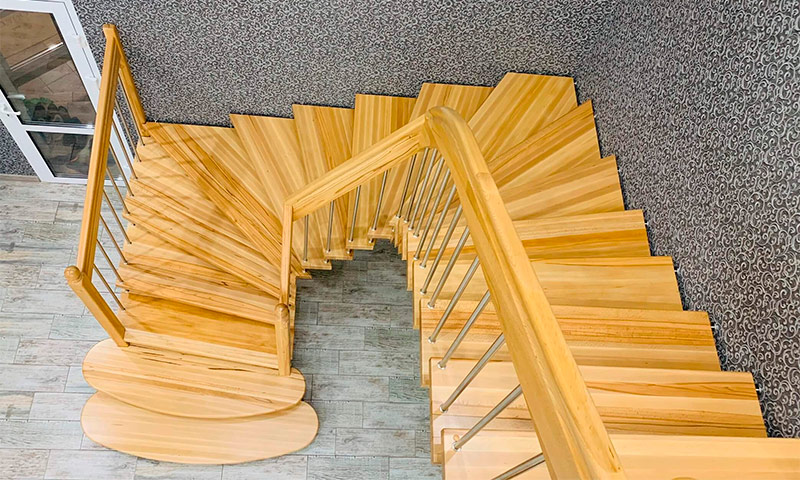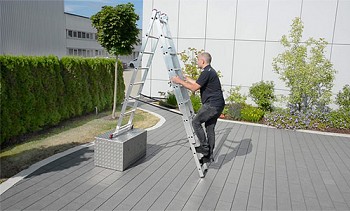From this article you will learn what types of stairs to the second floor there are for a private house. We will consider the types of stairs depending on the design of the supporting elements, the number and configuration of marches, the material and the manufacturing method.

Types of stairs for the design of load-bearing elements
The staircase consists of a power frame, to which all its parts are attached - steps, railings, balusters and decor. Depending on the design of the supporting elements, the following types of stairs are distinguished:
- On the skewers;
- On bowstrings;
- On Boltsy;
- Cantilever.
Kosoura stairs
Kosour - a power element of a ladder having ledges for each step. This is one of the most common types of load-bearing elements for stairs. There can be one or more kosour in the stairs.
The material of the steps and exterior may differ from the material of the kosour. Kosour is most often made of wood or metal, less often reinforced concrete.

Ladder on the kosoura.
Ladders consisting of one kosour are called stairs with a central kosour.

Staircase on the central Kosoura.
Stairs to the bowstrings
A bowstring is a supporting element similar to a kosour. The main difference in the method of attaching the steps. They are attached between two bowstrings in the internal grooves. Material - wood, reinforced concrete, metal. When installing the stairs on the bowstring, it is necessary to observe the accuracy of the installation of power elements.

Ladder on the bowstring.
Stairs
The staircase on the roofs is self-supporting, all loads are distributed between the steps, which are fastened by the roofs. Fasteners are left visible - they are part of the decorative finish and successfully fit into the interior in a high-tech style.
Advantages of the skeleton frame:
- maintainability - replacement of any element does not require dismantling of the remaining parts;
- there is no creaking - wooden elements do not touch each other;
- reliability - strong metal fasteners are used.

Ladder on the stairs.
Cantilever stairs
The cantilever type of stairs differs from the others in that the power frame is hidden, and visually it seems that the steps are not fastened. During finishing work, the power frame is closed, only profiles remain visible.

Cantilever staircase.
In addition to the four main types, their combinations are used in construction:
- kosour and bowstring;
- bowstring or kosour and pains;
- console and bolts;
- console and bowstring.
The difference in stairs in the number and configuration of marches
Marching stairs
Marching stairs - convenient, practical, reliable, consist of one or more marches. Each of them consists of a number of steps, in an amount from two to fifteen; more steps in one march are not recommended. Ascent and descent on such stairs occurs in a straight line, at an angle of 30-450 to the floor plane.
Marching stairs can be divided into the following types:
- stairs with a direct march;
- single-march swinging stairs with running steps;
- L-shaped stairs
- U-shaped stairs
1. Straight March Stairs
This type of staircase is the most convenient, but takes up the most space. In houses of a small area, it is not recommended to erect such structures.

One-flight staircase.
In rooms with high ceilings, two or more marches are mounted, making a platform between them.

One-flight staircase with a platform.
Structures with direct marches are recommended for houses where small children and elderly people live.
2. Single march swinging stairs with running steps
Swing single-flight staircases are used when the direct march exit is in an uncomfortable place, such as a wall.
Constructions with running steps and 90 degrees rotation.
Straight stairs with a 90-degree turn are used in private houses, where the exit from the straight section must be turned. Typically, the turn is done at the bottom, using the running steps. They combine the benefits of direct marching and spiral staircases. Convenient for installation in the corner of the room.

Staircase with stepping steps and a 90-degree turn.
Designs with running steps and 180 degrees rotation.
Similar to a 90-degree turn, stairs with a 180-degree turn allow you to save space and make a more gentle climb. An intermediate pad is not used; a U-turn takes place on the rungs.

Staircase with running steps and a 180 degree turn.
3. L-shaped stairs
The design of two marches located at an angle of 90 degrees to each other, connected by a platform, is called the L-shaped staircase.
Unlike a single-march swivel, it has the following advantages:
- the presence of the site makes it possible to rest when lifting the elderly, children;
- direct marches are more convenient than running stages;
- free space under the span where you can equip a cabinet or put interior items.

L-shaped staircase.
4. U-shaped stairs
The design of two straight marches, which are connected by a platform and turned 180 degrees relative to each other, is called a U-shaped staircase. This is the most common type in private houses and apartment buildings, public buildings.
The main advantages of such a ladder:
- comfortable movement on marches;
- the availability of free space;
- a large selection of materials for manufacturing, decoration.

U-shaped staircase.
Spiral stairs
Curved stairs without a central power element are called spiral. A characteristic difference is a round or oval staircase.
Spiral stairs are mounted in large rooms with high ceilings, since they take up a lot of space. Placement can be wall, repeating the bends of the wall or in the center of the room.
The size of the elements is a march width of 1.2 meters and a minimum external radius of 3.5-4 meters. They are appropriate in the halls of large country houses, hotels, business centers, offices.
May cause discomfort in people with a weak vestibular apparatus.

Spiral staircase.
Spiral staircases
Spiral staircases - structures with a central power element. All steps are attached to the central pillar. It takes up a minimum of space regardless of the height of the lift. It is used in rooms with low traffic intensity.
Walk on the spiral staircase carefully, holding onto the railing. People with a weak vestibular apparatus may have dizziness. The rise of large items on it is excluded. All furniture must be raised in advance or through a window.

Spiral staircase.
Goose step stairs
With limited space, a ladder with a large angle of inclination and steps oriented only under the left or right leg is used. This design is called "goose." Thanks to the direct march and a large angle of inclination, it takes up a minimum of space.For its operation or the lifting of overall objects will require skill.

Ladder goose step.
Types of stairs for the riser
Risers are decorative elements that are attached to the lower end of the step and cover the interior. Can be made of material different from the material of the steps.
Closed staircase with riser
Stairs with risers are called closed. The advantages of this design:
- load distribution, enclosed structures withstand more weight;
- beautiful interior;
- dust and debris are not collected inside the structure;
- risers do not allow the leg to fall through, it is very important for young children and the elderly.

Closed staircase with riser.
Open staircase without risers
The absence of risers makes the design open. In some cases, risers greatly spoil the appearance of the stairs, while they do not carry strong practical value. That is why most modern modular stairs are available without risers.

An open staircase without risers.
Material stairs
The material from which the supporting structure is made and the steps must withstand the design loads. Next, we consider the most common materials from which stairs are made.
Wooden stairs
Wood is the most ancient material, and in private household construction the most common. It is safe, environmentally friendly, and durable with proper care. It’s easy to work with wood, which allows you to make any staircase. The finished product is polished and coated with varnish, oil or tinting impregnations.
For the manufacture of stairs, solid oak varieties of oak, ash, etc. are most often used. Combined options are also encountered when balusters and other elements that do not carry high loads are made of less valuable types of wood, and the remaining elements are made of oak.
Of the shortcomings, it should be noted that the tree requires periodic maintenance, and with deficiencies in the design, over time, wooden stairs begin to creak.

Wooden staircase.
Metal stairs
Metal is a strong and durable material. Most often it is used for the manufacture of a power frame, less often for the manufacture of steps and railings. Bent, forged or welded metal structures are used. Metal goes well with the decor of glass, stone, wood. The main disadvantage of metal stairs is the complexity of manufacturing.

Metal staircase.
Glass stairs
Glass elements make the design light and airy. Such designs do not fit into every interior, but impressionable people have a feeling of discomfort when descending the glass steps.
Among the shortcomings, it should be noted the complexity of installation and processing, as well as the fact that over time chips and scratches appear on the elements.

Metal staircase.
Natural stone stairs
Stone stairs are made of:
- marble;
- granite;
- artificial stone.
Such designs require a powerful power frame, usually have large sizes and are not appropriate in any home.

Staircase made of stone.
Reinforced concrete
Reinforced concrete stairs are common in multi-story residential construction, as well as in public, industrial buildings. Installation in a private house is possible only at the construction stage.

Concrete staircase.
Combined
In combined staircases, the power frame is made of one material, and the steps and decor are made of another.

Combined staircase made of metal and wood.
Stairs depending on the manufacture
The price of a staircase for a home depends on the size of the structure, type of staircase, materials and manufacturing method.
Modular stairs
Modular stairs are manufactured at the factory. All elements of such stairs are standardized and passed the necessary tests. Available in different sizes. Due to serial production, the price of such structures is less.

Simple modular staircases are easy to assemble.
Custom made stairs
The quality of custom stairs depends on the professionalism of the manufacturer and installation technicians. Installation of such a structure can be performed at any stage of construction.

Complex designs are made to order and installed by specialists.

